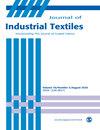对减少氡女儿放射性剂量的商用面罩进行评估
IF 2
4区 工程技术
Q1 MATERIALS SCIENCE, TEXTILES
引用次数: 0
摘要
商用口罩已成为 COVID-19 大流行期间的常用工具。它们价格便宜,使用简单,有些还能过滤掉空气中的大部分微粒,保护使用者。这些特性通常用于对付有害病毒或污染物,但也可用于防止氡引起的放射性剂量,而氡是导致全球肺癌的第二大原因。因此,本研究的主要目的是验证口罩能否防止氡衰变产物进入潜在用户的肺部。由于这些衰变产物是放射性剂量的主要来源,我们对几种商用口罩进行了测试,将它们暴露在氡中,然后用伽马光谱法测量氡子体的存在。由棉、聚酯或氯丁橡胶等材料制成的可重复使用的口罩似乎效率不高,过滤效率只有 40%,聚丙烯编织口罩是唯一的例外,过滤效率为 80%。外科口罩的过滤效率在 90% 到 98% 之间。事实证明,FFP3 和 FFP2 最为可靠,几乎可以完全过滤掉氡女儿,过滤效率高达 98%。结果证明,在无法使用或不宜使用其他技术的地方,使用 FFP3 和 FFP2 口罩可以成为减少氡引起的放射性剂量的有用工具。本文章由计算机程序翻译,如有差异,请以英文原文为准。
Evaluation of commercial facemasks to reduce the radioactive dose of radon daughters
Commercial facemasks have become a common tool during the COVID-19 pandemic. They are cheap, simple to use and some are capable of filtering out most particles in the air, protecting the user. These qualities are usually employed in relation to hurtful viruses or contaminants, but they could also be used to prevent the radioactive dose due to radon, which is the second leading cause of lung cancer worldwide. For that reason, the main goal of this study is to verify if facemasks could prevent radon decay products from entering the potential user’s lungs. Since these decay products are the main source of radioactive dose, several commercial facemasks were tested by exposing them to radon and then measuring the presence of radon daughters by gamma spectroscopy. Reusable facemasks made from materials such as cotton, polyester or neoprene appeared to be inefficient with only 40% filtering efficiency, Polypropylene woven masks being the only exception, with 80% efficiency. Surgical masks presented filtering efficiencies between 90 and 98%. FFP3 and FFP2 proved to be the most reliable, almost completely filtering out radon daughters with filtering efficiencies up to 98%. Results prove that the use of FFP3 and FFP2 facemasks could be a useful tool to reduce the radioactive dose due to radon in places where other techniques cannot be used or are not advisable.
求助全文
通过发布文献求助,成功后即可免费获取论文全文。
去求助
来源期刊

Journal of Industrial Textiles
MATERIALS SCIENCE, TEXTILES-
CiteScore
5.30
自引率
18.80%
发文量
165
审稿时长
2.3 months
期刊介绍:
The Journal of Industrial Textiles is the only peer reviewed journal devoted exclusively to technology, processing, methodology, modelling and applications in technical textiles, nonwovens, coated and laminated fabrics, textile composites and nanofibers.
 求助内容:
求助内容: 应助结果提醒方式:
应助结果提醒方式:


